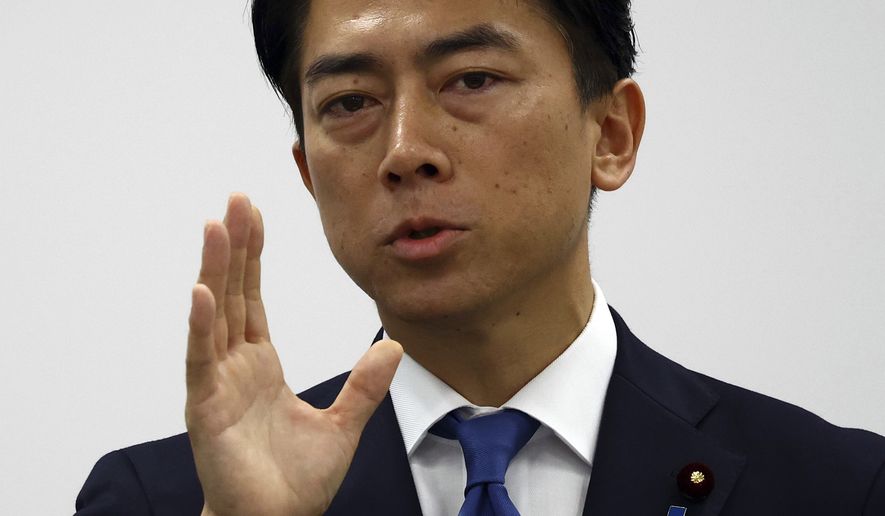BANGKOK, Thailand — Beijing’s hybrid war tactics are fueling fierce blowback in Japan and the Philippines, two U.S.-allied island nations ideally suited to thwart a Chinese encirclement or blockade of Taiwan.
Dressed in a fatigue jacket and flanked by tactically uniformed members of the Ground Self Defense Force, Japanese Defense Minister Shinjiro Koizumi spoke to the media on Yonaguni island, just 65 miles off Taiwan, Sunday about the emplacement of medium-range air-defense systems.
Mr. Koizumi delivered a stern message sure to be heard in Beijing, where China’s communist government, infuriated by Japanese Prime Minister Sanae Takaichi’s remarks equating Taiwanese security and Japanese security, has been blistering Tokyo via rhetorical, diplomatic and economic channels.
“The deployment can help lower the chance of an armed attack on our country,” Mr. Koizumi said, according to Bloomberg, on his first trip to Japan’s southernmost island, in the Ryuku Chain, between Japan and Taiwan.
He subsequently spoke to Yonaguni Mayor Tsuneo Uechi, making the case for the necessity of defensive measures.
There has been disquiet across the Ryukyus: The chain’s largest island, Okinawa, suffered devastation in World War II. There are concerns that new bases there could make the island a target if a Taiwan crisis turns hot.
For many Japanese, the biggest perils facing the Ryukyus have long been natural: Tropical storms, and a series of shark attacks off Miyako, a popular vacation getaway, in 1996, 1997 and 2000.
But in a long-term movement, Japanese military units are shifting from Russia-facing Hokkaido in Japan’s north to the China-facing Ryukyus in the southwest.
Mr. Koizumi’s appearance over the weekend underscored that shift.
“There is some restraint, but this is still pushback,” said Drew Thompson, a senior fellow at the Rajaratnam School of International Studies at Singapore’s Nanyang Technological University. “It is a sign that Japan will not be intimidated.”
Since 2016, Japan has been expanding its military presence across the islands, with new bases coming online in 2024. Ishigaki hosts anti-ship missile batteries, while Miyako — dominating the deep-water Miyako Strait — is home to a range of military facilities.
The missile unit being emplaced in Yonaguni joins radar and electronic warfare bases..
Japan’s Self Defense Forces are not alone in the area.
Okinawa is a key, regional U.S. Marine hub. Across the Indo-Pacific, Marines’ tasks are expanding from beach assault to littoral defense, using mobile, long-range rocket artillery and drones.
For two months prior to Mr. Koizumi’s visit, Marines undertook reinforcement and equipment buildup exercises on Yonaguni.
“The Corps aims to make Yonaguni Island a focal point in its First Island Chain strategy,” Naval News wrote last week.
The specialist media noted that the activities had prompted a Chinese drone flight through the area — which itself prompted a counter-flight by Japanese F15s. Chinese media have fretted that expanded runways on the island could accommodate F-35B short-takeoff and landing stealth fighters.
The developments present massive headaches for Chinese admirals as the Ryukyus dominate strategic straits on Taiwan’s north-eastern flank.
Similar dynamics are in play on Taiwan’s southwestern flank. There, the U.S. and the Philippines have been building up the northernmost island chain, Batanes. U.S. troops have also been deploying long-range missiles batteries to Philippine soil, angering Beijing.
The efforts could deny the strategic Bashi Channel, between Taiwan and the Philippines, to Chinese shipping.
The closure of maritime choke points on both sides of Taiwan present Chinese war planners with bad choices if party leadership ever decides to take the democratic island by force.
One would be to preemptively strike the bases, which would bring the U.S. and its Asian allies into the conflict.
A second would be to send warships through the straits, in the hope that they would not be struck.
A third would be to ditch the “python” — an encirclement and strangulation strategy that would include simply striking directly across the 110-mile-wide Taiwan Strait with naval, amphibious and airborne forces.
That is doubly risky. Taipei is acquiring weapons to stem such an assault: cruise missiles, loitering munitions, stealthy sea mines, even Abrams tanks firing from hull-down positions on the beaches.
Tokyo’s and Manila’s moves are taking place against a backdrop of Chinese hybrid, or gray-zone, tactics.
Beijing initiated a multi-pronged offensive against Tokyo following Ms. Takaichi’s comments on Nov. 7.
Chinese diplomats have threatened violence against her, demanded a retraction, and even sent a letter to the U.N. State media is lambasting her, and anti-Japanese protests have taken place. Beijing has warned its tourists not to visit Japan, and halted Japanese seafood imports.
Meanwhile, Chinese fishing fleets, Coast Guard and naval vessels are claiming maritime terrain and securing features in the South China Sea, west of the Philippines. Tactics include intimidation, water-cannoning and rammings.
Rather than cowing opposition, Beijing is generating it.
A Yomiuri newspaper poll from Nov. 24 found that 56% of Japanese approve of Ms. Takaichi’s hawkish views on China, versus 29% who do not.
“The tragedy for Beijing is that it is more committed to coercion and force than incentives,” said Mr. Thompson, formerly director, China, Taiwan and Mongolia in the Office of the Assistant Secretary of Defense for Asian and Pacific Security Affairs. “It is threatening its neighbors and they are responding.”
According to Mr. Thompson, Beijing’s efforts are compelling Washington’s allies to request “greater involvement and commitment” of the U.S. military in the region.
The Yomiuri’s weekend poll also found that 77% of Japanese approved of Ms. Takaichi’s October summit with U.S. President Trump, versus 16% who did not.
• Andrew Salmon can be reached at asalmon@washingtontimes.com.




Please read our comment policy before commenting.